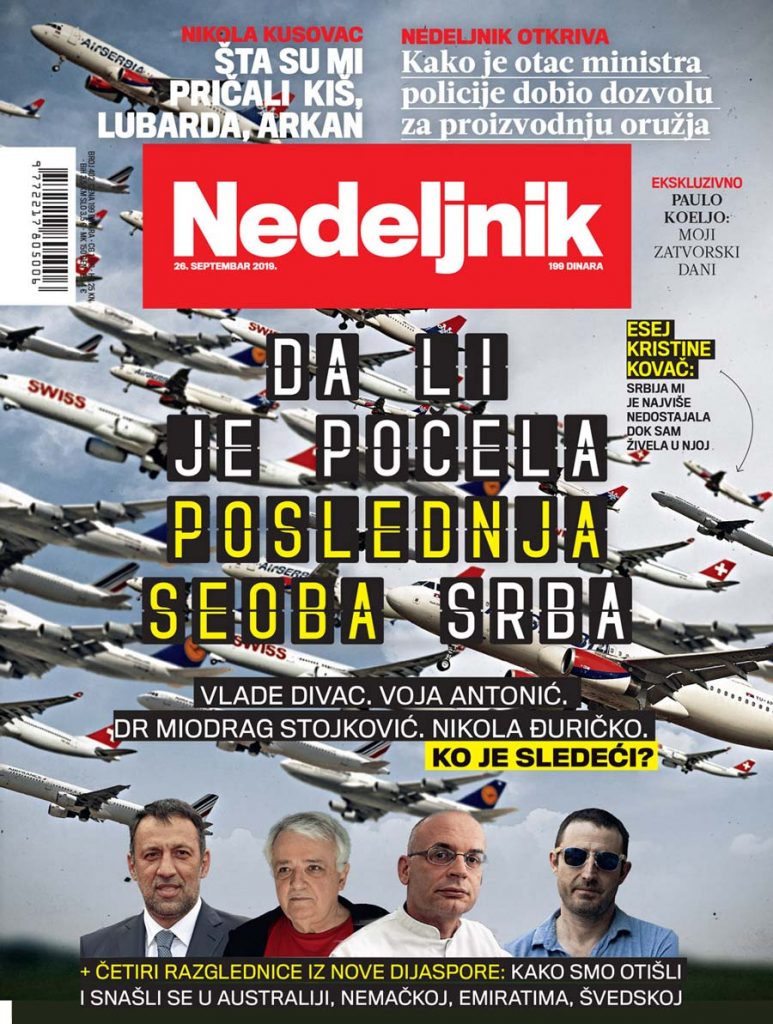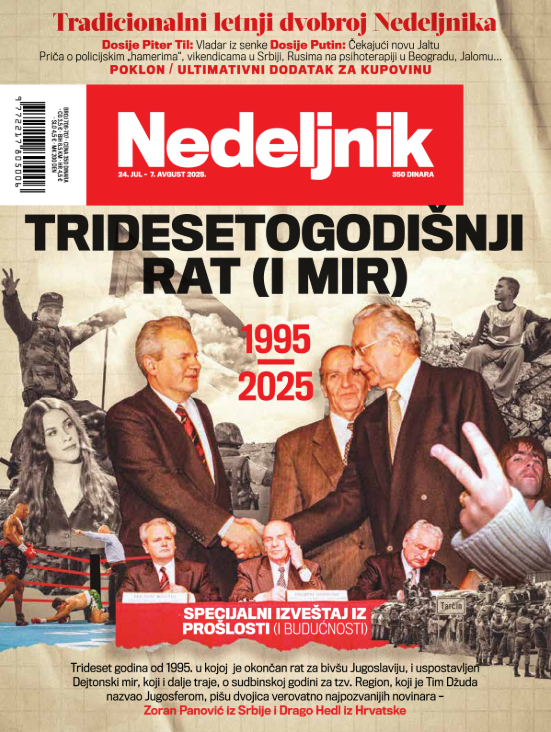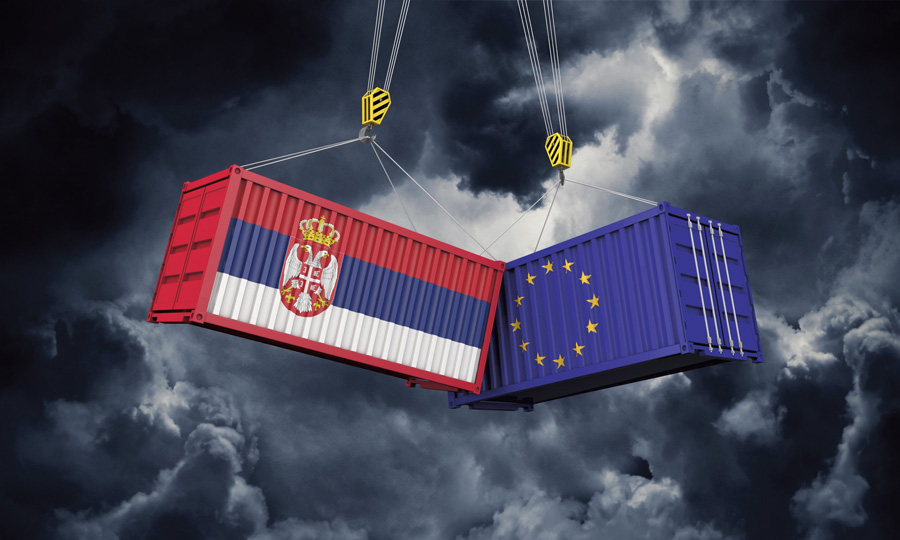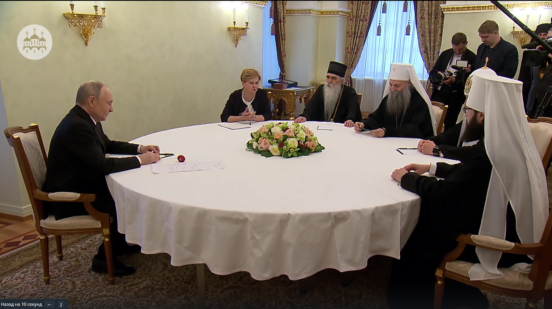
With the passing of the Milosevic era, successive reform-minded Serbian governments have made membership in the EU their primary foreign policy goal. Each government has longed for Serbia to become a “normal” European country: democratic, free enterprise, multi-ethnic and open. And, Serbia has made important strides to those ends. The crowning achievement in that process will be satisfying all chapters of the Acquis Communautaire and being awarded full membership in the EU. But, since that goal was set in the early 2000s, Serbia, the EU and Europe have changed and EU membership for Serbia seems less certain and less advisable. In fact, EU membership now actually may be detrimental to Serbia’s national interests. Ironically, EU membership especially may damage the goal of sustained economic development.
In November 2007 Serbia and the EU signed a Stabilization and Association Agreement (SAA), the first major step on the long road to membership, and in December 2009 Serbia formally applied for full EU membership. The EU Commission reciprocated and accepted Serbia as a full candidate in March 2012 and in January 2014 the EU Council opened negotiations with Belgrade. However, since January 2014 only two of the 35 chapters of the Acquis Communautaire have been closed (25: Science and Research and 26: Education and Culture). The most difficult chapters lie ahead, including chapter 35, Serbia’s relations with Kosovo.
Although Serbia’s bid for accession to the EU started slowly after Milosevic was forced from office, it gradually gathered momentum and has been routinely promoted and encouraged by the EU Commission. In 2003, when the applications of the countries of the Western Balkans was in doubt, the President of the Commission, the heads of states or governments of several EU member countries and many other European officials assured representatives of all the Western Balkan states that their future was accession into the EU. The joint Declaration of the Thessaloniki Summit lauded the “…shared values of democracy, the rule of law, respect for human and minority rights, solidarity and a market economy…respect for international law, inviolability of international borders, peaceful resolution of conflicts and regional co-operation….” The Declaration also affirmed “full implementation of Resolution 1244 on Kosovo…the Dayton/Paris Agreements (on Bosnia) and the Ohrid (Macedonia) and Belgrade (Montenegro) agreements.”
Ever since the landmark Thessaloniki Declaration, the EU Council and Commission publicly and repeatedly has affirmed that its intention to integrate the countries of the Western Balkans into the EU. This started formally with a conference in Berlin in 2014 which established an intergovernmental process to revitalize tie between the EU and the Western Balkans after a period of prolonged inactivity. The “Berlin Process” has continued ever since 2014. In 2015 s subsequent summit was held in Vienna, in 2016 in Paris and in 2017 in Trieste. In May 2018, at the EU-Western Balkans Summit in Sofia, Jean-Claude Juncker, President of the EU Commission declared that “…this summit has allowed us to forge even closer links with our friends from the Western Balkans who…each day come a little closer to the European Union…” with all the mutually shared values. Later, in July 2018, a larger Western Balkans Summit held in London where similar assurances were given to the countries of the Western Balkans.
Head Winds!
At the same time the EU was reaffirming its commitment to the Western Balkans and the Western Balkans continued to demonstrate an overwhelming desire to join the EU, countervailing forces were conspiring to make EU membership less appealing and more difficult. The entire EU process began as an outgrowth of World War II. It was a bold effort to end the centuries of intra-European warfare and create institutions and policies that fostered cooperation and peaceful interactions among European countries. The first effort was the establishment of the European Coal and Steel Community (ECSC). The Treaty of Paris in 1951 committed Belgium, France, Italy, Luxembourg, The Netherlands and West Germany to a common regulation of industrial production under a centralized authority.
The ECSC was followed quickly by the European Atomic Energy Commission (EURATOM), established by treaty in 1957 and dedicated to establish a common market for nuclear energy. Also in 1957 the Treaty of Rome established the European Economic Community (EEC), which took economic integration and cooperation to a higher level. The EEC survived until 1993 when the European Community (EC) was created by the Maastricht Treaty, which was the first step European countries took to expand their cooperation beyond economic issues into political, diplomatic, security and legal questions. Finally, in 2009 the Treaty of Lisbon transformed the EC into the European Union (EU), which was designed to be the next major step in the unification of Europe across the competencies that had been begun by the EC.
The post-World War II experiment in supra-nationalism has not ended completely and it is unlikely that the EU will totally fall apart, but it now is at the lowest point since before the inception of the ECSC. It is unlikely the EU will regain the momentum and levels of development that culminated in 2009. Two immediate events—the financial crisis of 2008 and the refugee crisis that began in 2015—triggered the retreat and fracturing of the EU. But, the basic, more strategic problem goes much deeper.
Perhaps the most important determinant in the retreat and weakening of the EU process is the crumbling of the post-World War II U.S.–led liberal world order. Clearly, American power has waned—not in an absolute sense, but in relation to other countries and non-state actors with whom the U.S. must now share the world stage. The challenge to American leadership has been seen most keenly in economic competition, the changing nature of warfare and political dominance. The U.S. is being challenged by China, Russia, Brazil, India and a host of non-state organizations, such as Hezbollah, Hamas and others. The relative decline of American power has had a significant negative impact on the idea of a solidified “Euro-Atlantic” Community. In a number of areas, Europe has had to learn to go their own way without the dominating authority of the U.S. that was typical for the non-Communist world during the era of bipolarity. The era of American hegemony was relatively short and is now passé.
Within this broader realignment of world structure and function, Europe has been going through a renationalization of politics. In short, this means that there is a movement among many—perhaps most—European countries to turn away from the supra-national ethos of the EU and to a reliance on an older idea of national identity and sovereignty. In most European states, this has manifested itself in the rise of the far right and in some countries it has resulted in control of the national government by the right. We see this most prominently in Poland, Hungary and Italy. In most other countries, the far right does not control the government, but in elections over the past two to three years the far right has made impressive gains. Most recently, more traditional centrist and left-center parties have made a come-back, but there is no indication that the far right and the renationalization of European politics has passed.
The most concrete example is of the renationalization of politics has been Brexit, the decision by British voters to leave the EU. The seemingly unending Brexit saga is leading the way for Europe to come to grips with questions such as “how much unification,” the struggle for what the European state means, how to define European culture—once the world’s leader in defining culture, is now a cultural back water. Inevitably, this discussion—and debate—on such issues as borders, currency, language, cooperation and modernization and development in 21st century Europe.
Closely associate with the renationalization of European politics is the emergence of several tiers of economic and political differentiation. Geographically, the several tiers flow from northwest to the south and southeast–the wealthiest, most developed states in the northwest to the poorest and least developed in the southeast and south. The wide economic diversity, compounded by renationalization, have led to significant differences in national interests and national capabilities. While economies in northwest boom, those in the south and southeast struggle. Stable political systems in the northwest compare strikingly with less stable system in the south and southeast. The Greek financial crisis, Italy’s shaky economic picture and lurch to the right, Spain’s economic floundering, economic and corruption problems in Bulgaria and Romania and sluggish economic growth in the Western Balkans all compare unfavorably with Germany, France and the low countries, despite their own vexing issues. The net effect of significant tiering has been to cause important cracks in what was once a more cohesive organization.
The cumulative effect of these issues, coupled with the entropy brought on by the weight of time, has led to a certain enlargement fatigue. The enlargement process is nearing its end. It can go no further east; officials in Ukraine and Turkey realize finally that they will not get into the EU. The development process has slowed down in the Western Balkans. Bulgaria and Romania have been sanctioned by the EU and Poland and Hungary have been threatened with sanction. Nonetheless, the EU is not going away. Large institutions normally do not collapse from exhaustion or dysfunction. They tend to survive through inertia, perhaps providing some useful benefit but not as much as they were intended to provide. They become a shell of their former self; an organization without a teleology.
Serbia’s Dilemmas!
Belgrade’s desire to make Serbia a “normal” European country is rooted in the sense of being seen as a pariah state during the Milosevic years and in centuries of self-inflicted victimhood. The desire is genuine, but the value Serbia would get from EU membership is debatable. It is especially questionable for the Serbian economy.
There are three dilemmas. First, Serbia has had a free trade agreement with the EU since 2008. Seventy-six percent of Serbia’s trade already is with EU countries and more than one quarter of that trade is with EU members Germany, Italy and Romania. But, pre-accession aid will end once Serbia becomes a members of the EU. It is difficult to see how Serbia’s trade could improve very much beyond pre-accession numbers as full EU members. And, trying to expand trade outside the EU could lead to blowback from Brussels. This is especially true as Serbia works to expand trade with Russia and will not conform to the EU’s sanctions against Moscow.
Second, the EU and some of its members are making it more difficult to negotiate trade deals with other countries. In 2018 the EU Commission tightened the rules for receiving foreign direct investment (FDI) by EU members. Arguing that it is necessary to protect national security, EU officials are in the process of defining and applying more stringent screening rules for EU member state to receive FDI from outside the EU. The action is aimed mostly at China, which pursues a vigorous FDI strategy in Europe. These new rules also could make trade and FDI with Russia more problematic. The Financial Times recently proclaimed that in 2018 Serbia received $4.2 billion in FDI, the world’s leading recipient relative to the size of its economy. Although FDI has brought much needed cash to the Serbian economy, the FDI will end when and if Serbia becomes an EU member. It is unlikely that Serbia will receive grants as generous as a full EU member will. Belgrade will be expected to contribute to the overall EU budget. Moreover, tightening of the rules could make it more difficult to continue receiving high levels of FDI.
Third, there is an associated problem. Large portions of the Serbia economy is owned by foreign sources. Indeed, over 55 percent of commercial space in Serbia is owned by foreigners and more than 50 percent of Serbian exports are produced by majority foreign-owned companies. Large portions of the Serbian economy are owned by companies from all over the world. But the most important foreign owners are China and Russia. For example, a Chinese company now owns the Smederevo Steel mill and owns a controlling interest in RTB Bor copper mine and smelter. Last spring Serbia and China signed a large deal as part of China’s Belt and Road Initiative that will give Beijing major contracts in innovation and infrastructure development in Serbia. Russia and Serbia have concluded several major arms deals and Russia’s Gazprom has been able to buy more than 56 percent of Naftna Industrija Srbije (NIS), the Serbian national oil company. The growing presence of foreign ownership in Serbia is driven by the need for cash. But, in the long run the loss of Serbian patrimony may well lead Serbia into becoming primarily a rentier state, with less and less ability to control its own assets. Moreover, the continuing sale of major portions of the economy to foreigners—especially to China and Russia–is likely to lead to problems with the EU’s concern with foreign control of European assets.
Where to Go?
Serbia’s leadership needs to consider whether full membership is really in the best interests of Serbia or whether they simply want to join to demonstrate that Serbia is now an “acceptable” country. To arrive at a reasonable answer, Serbian leadership needs to answer the following questions:
What will Serbia gain economically from EU Membership? Or, would Serbia be better off by continuing to construct an expanding network of bilateral economic relationships similar to what it has now?
Will full membership allow Serbia to continue to continue to deepen and broaden economic ties with non-EU countries? Or, will Serbia have to curtail those ties to conform to tightening EU regulations and restrictions on some countries that (such as China)?
Will EU membership give Serbia greater political clout in Europe? Or, would Serbia—a small country in the poorest part of Europe–ensure that it will never be able to compete politically as an equal partner with the major powers in northwest Europe?
Will Serbia be able to retain what is left of its economic patrimony with full membership? Or, will Serbia continue to lose valuable economic assets.
Will the EU be able to return to the vibrant, healthy organization it was 20 years ago? Or, will the EU continue to crack and decline, resulting in a multi-tiered organization that will struggle to maintain its relevance?
How much of the government’s Economic Reform Package (currently focused on 2018-2020) will have to be reorganized and reoriented?
A version of this article in Serbian was published in Nedeljnik, in September 26th issue.












